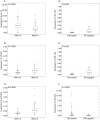Validation of expression patterns for nine miRNAs in 204 lymph-node negative breast cancers
- PMID: 23144930
- PMCID: PMC3492447
- DOI: 10.1371/journal.pone.0048692
Validation of expression patterns for nine miRNAs in 204 lymph-node negative breast cancers
Abstract
Introduction: Although lymph node negative (LN-) breast cancer patients have a good 10-years survival (∼85%), most of them still receive adjuvant therapy, while only some benefit from this. More accurate prognostication of LN- breast cancer patient may reduce over- and under-treatment. Until now proliferation is the strongest prognostic factor for LN- breast cancer patients. The small molecule microRNA (miRNA) has opened a new window for prognostic markers, therapeutic targets and/or therapeutic components. Previously it has been shown that miR-18a/b, miR-25, miR-29c and miR-106b correlate to high proliferation.
Methods: The current study validates nine miRNAs (miR-18a/b miR-25, miR-29c, miR-106b, miR375, miR-424, miR-505 and let-7b) significantly correlated with established prognostic breast cancer biomarkers. Total RNA was isolated from 204 formaldehyde-fixed paraffin embedded (FFPE) LN- breast cancers and analyzed with quantitative real-time Polymerase Chain Reaction (qPCR). Independent T-test was used to detect significant correlation between miRNA expression level and the different clinicopathological features for breast cancer.
Results: Strong and significant associations were observed for high expression of miR-18a/b, miR-106b, miR-25 and miR-505 to high proliferation, oestrogen receptor negativity and cytokeratin 5/6 positivity. High expression of let-7b, miR-29c and miR-375 was detected in more differentiated tumours. Kaplan-Meier survival analysis showed that patients with high miR-106b expression had an 81% survival rate vs. 95% (P = 0.004) for patients with low expression.
Conclusion: High expression of miR-18a/b are strongly associated with basal-like breast cancer features, while miR-106b can identify a group with higher risk for developing distant metastases in the subgroup of Her2 negatives. Furthermore miR-106b can identify a group of patients with 100% survival within the otherwise considered high risk group of patients with high proliferation. Using miR-106b as a biomarker in conjunction to mitotic activity index could thereby possibly save 18% of the patients with high proliferation from overtreatment.
Conflict of interest statement
Figures




Similar articles
-
Biologic profiling of lymph node negative breast cancers by means of microRNA expression.Mod Pathol. 2010 Dec;23(12):1567-76. doi: 10.1038/modpathol.2010.177. Epub 2010 Sep 3. Mod Pathol. 2010. PMID: 20818337
-
Differential expression of the miR-17-92 cluster and miR-17 family in breast cancer according to tumor type; results from the Norwegian Women and Cancer (NOWAC) study.J Transl Med. 2019 Oct 3;17(1):334. doi: 10.1186/s12967-019-2086-x. J Transl Med. 2019. PMID: 31581940 Free PMC article.
-
MiR-18a and miR-18b are expressed in the stroma of oestrogen receptor alpha negative breast cancers.BMC Cancer. 2020 May 5;20(1):377. doi: 10.1186/s12885-020-06857-7. BMC Cancer. 2020. PMID: 32370743 Free PMC article.
-
[microRNA expression in breast development and breast cancer].Pathologe. 2013 Nov;34 Suppl 2:195-200. doi: 10.1007/s00292-013-1878-7. Pathologe. 2013. PMID: 24196612 Review. German.
-
MicroRNA-21 in breast cancer: diagnostic and prognostic potential.Clin Transl Oncol. 2014 Mar;16(3):225-33. doi: 10.1007/s12094-013-1132-z. Epub 2013 Nov 19. Clin Transl Oncol. 2014. PMID: 24248894 Review.
Cited by
-
Hsa-miR-375/RASD1 Signaling May Predict Local Control in Early Breast Cancer.Genes (Basel). 2020 Nov 26;11(12):1404. doi: 10.3390/genes11121404. Genes (Basel). 2020. PMID: 33255991 Free PMC article.
-
Hsa-miR-375 is a predictor of local control in early stage breast cancer.Clin Epigenetics. 2016 Mar 8;8:28. doi: 10.1186/s13148-016-0198-1. eCollection 2016. Clin Epigenetics. 2016. PMID: 26962366 Free PMC article.
-
The Role of miR-375-3p, miR-210-3p and Let-7e-5p in the Pathological Response of Breast Cancer Patients to Neoadjuvant Therapy.Medicina (Kaunas). 2022 Oct 20;58(10):1494. doi: 10.3390/medicina58101494. Medicina (Kaunas). 2022. PMID: 36295655 Free PMC article.
-
Nutraceuticals in the Mediterranean Diet: Potential Avenues for Breast Cancer Treatment.Nutrients. 2021 Jul 26;13(8):2557. doi: 10.3390/nu13082557. Nutrients. 2021. PMID: 34444715 Free PMC article. Review.
-
Comparative microRNA profiling of sporadic and BRCA1 associated basal-like breast cancers.BMC Cancer. 2015 Jul 8;15:506. doi: 10.1186/s12885-015-1522-4. BMC Cancer. 2015. PMID: 26152113 Free PMC article.
References
-
- Perou CM, Sorlie T, Eisen MB, van de Rijn M, Jeffrey SS, et al. (2000) Molecular portraits of human breast tumours. Nature 406: 747–752. - PubMed
-
- Yang XR, Sherman ME, Rimm DL, Lissowska J, Brinton LA, et al. (2007) Differences in risk factors for breast cancer molecular subtypes in a population-based study. Cancer Epidemiol Biomarkers Prev 16: 439–443. - PubMed
-
- Fan C, Oh DS, Wessels L, Weigelt B, Nuyten DS, et al. (2006) Concordance among gene-expression-based predictors for breast cancer. N Engl J Med 355: 560–569. - PubMed
-
- Carey LA, Perou CM, Livasy CA, Dressler LG, Cowan D, et al. (2006) Race, breast cancer subtypes, and survival in the Carolina Breast Cancer Study. JAMA 295: 2492–2502. - PubMed
Publication types
MeSH terms
Substances
LinkOut - more resources
Full Text Sources
Other Literature Sources
Medical
Research Materials
Miscellaneous

